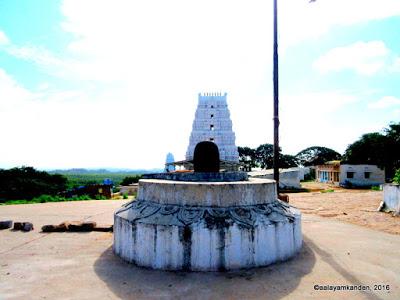
Sri Ramalingeswara Temple at Keesaragutta
India has a number of temples associated with the Ramayana legend. Sometimes we even find similar legends associated with temples across states. All these legends glorify the life of Rama, and the devotion Hanuman had for him.One such temple that is associated with Ramayana is Keesaragutta. After the killing of Ravana, Rama was returning home. During his journey back, he installed Shivalingams at different places, not just to be rid of the Brahma Hathi Dosham he acquired due to the killing of Ravana, but also to give peace to all those who lost their lives in the war, and to thank Lord Shiva for helping him reach and rescue Sita Devi safely.
On his way back, he saw a beautiful hill side and lush green valley, a perfect location to stop by, and worship Lord Shiva. So he alighted there and requested Hanuman to get him a Shivalingam for worship. Hanuman immediately assumed Viswaroopa and set off to Kashi to bring back a suitable lingam for Rama's worship.

On reaching Kashi, he was not able to decide which lingam would be suitable as each one of them presented with a unique feature. Not wanting to make the wrong decision, he picked up 101 lingams in both his hands and started on his way back.
In the meantime, since it was getting closer to dusk, Rama wanted to complete his pooja. As there was no sight of Hanuman, he prayed to Shiva to help him. Lord Shiva manifested before Rama in the form of a swayambu lingam. Rama started worshipping Shiva. Half way through the pooja, Hanuman came, carrying the 101 lingams.
He was shocked to see Rama already performing poojas. Dejected, he threw away all the lingams he had brought from Kashi. Rama noticed Hanuman's disappointment, and pacified him. He also installed one of the lingams brought by Hanuman and assured him that the first pooja will always be performed to the Hanumad Lingam. Moreover, he said that the name of the hill would be known as Kesarigiri, after Hanuman, the son of Kesari. Over time, Kesarigiri has come to be known as Keesaragutta.

Maruthi Kashi Lingeswara Temple
Even today, over sixty lingams of different shapes and sizes are found strewn all over the hill, in and around the temple. Ramalingeswara, is found in the sanctum sanctorum and the Maruthi Kashi Lingeswara in a seperate shrine across the temple. A huge Viswaroopa Hanuman is found right next to the shrine. Just like the other temples in this area, devotees are allowed to directly perform abhishekams for Ramalingeswara from 6 am to 12 pm every day.
After crossing the huge temple arch on the main road, one comes across the Nagadevatha shrine, where a beautiful Goddess with entwining snakes all over is found. Devotees stop here first and offer prayers, sprinkle turmeric and Kumkum powder on the Goddess and then proceed towards the Keesaragutta temple.
Apart from the main deity, there are seperate shrines for Goddess Parvathi, known here as Bhavani Matha, Ganesha, Subramanya, Rama, Sita, Lakshmana, Mahalakshmi, Makaali, Mahasaraswathi, and Sivapanchayadhana Moorthy. This temple is known as Ubhaya Rameshwaram.
Another unique feature of this temple is Lord Lakshmi Narasimha in a seperate shrine. This Narasimha is a Varaprasadhi, bringing harmony among married couples and helping cure dreadful diseases. The Narasimha has been installed by the Akkana and Madanna brothers, who were viziers of the Golconda Sultanate. There is also a Vedapadashala at the temple that is run by the Tirumala Tirupathi Devasthanams.

Vishwaroopa Hanuman
On one side of the temple, there is a lotus pond and Goddess Sita Devi is found in a cave nearby. Remnants of the Golconda style of architecture can also be seen all around the temple.King Madhava Varma II of the Vishnukundina dynasty is said to have patronized this temple largely and also performed an Ashwamedha Yagna here in the 5th Century. During his reign, Keesaragutta was the location of the military base. The antiquity of this temple has been established through several archaeological excavations that have taken place here. The findings have revealed the strong existence of Buddhist and Jain culture in these areas .
Twelve Jain Thirthankara statues have been found at about one feet. The remnants of the original temple built during the Vishnukundina period, built of brick, with rectangular structures having five shrines with circumambulatory path, and square garbagriha,remains of a fort, along with antiquities such as shell bangles, coins, stucco figures, huge statues of Mother Goddess (Laja Gauri), lingas of crystal, Vishnukundin coins, pottery circles, red ware, black ware and gray ware.


How to get here: Keesaragutta is in Rangareddy District, about 35 kms from Hyderabad city. It is about 18 kms from ECIL X road. Temple Timings: 6 am - 1 pm, 3 pm to 7.30 pmContact Details: 08418-202200
